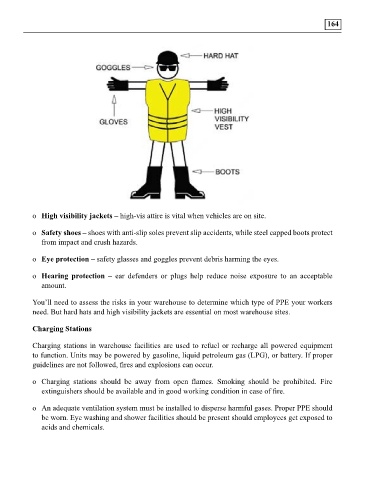Page 164 - Warehouse 1 to 9
P. 164
164 165
Materials Storage
Improper stacking of loads and storage of materials in shelves can result in unintended slip and trip
hazards for nearby workers.
o Keep aisles and passageways clear and in good condition, this prevents workers from slipping,
tripping, or falling.
o Loads should be placed evenly and properly positioned, heavier loads must be stacked on lower
or middle shelves. Always remember to remove one load at a time
o Ensure proper lifting procedures when employees physically lift and move warehouse items.
Conveyors
Conveyor equipment is commonly used in warehouse facilities to transport goods. However,
conveyors pose serious dangers to workers including getting caught in equipment and being struck
by falling objects. To remain safe, it is important to:
o Ensure proper safeguarding equipment between the conveyor and the worker to protect against
o High visibility jackets – high-vis attire is vital when vehicles are on site. entanglement of clothing, body parts and hair.
o Safety shoes – shoes with anti-slip soles prevent slip accidents, while steel capped boots protect o Follow proper lock out tag out procedures during conveyor maintenance and repairs.
from impact and crush hazards.
o To prevent conveyor accidents, ensure that belts are checked and inspected regularly, and that
o Eye protection – safety glasses and goggles prevent debris harming the eyes. employees are trained in conveyor safety.
o Hearing protection – ear defenders or plugs help reduce noise exposure to an acceptable o Place adequate guards on pinch points.
amount.
o Use lockout options so employees can shutdown conveyor operations quickly. Install adequate
You’ll need to assess the risks in your warehouse to determine which type of PPE your workers lighting around conveyor operations.
need. But hard hats and high visibility jackets are essential on most warehouse sites. Docks
Charging Stations Warehouses use docks to load and offload inventory or raw material. The hazards that exist with
docks include driving forklifts off docks and equipment accidents involving products improperly
Charging stations in warehouse facilities are used to refuel or recharge all powered equipment placed that fall on employees. To follow guidelines, clearly mark the edge of the dock and ensure
to function. Units may be powered by gasoline, liquid petroleum gas (LPG), or battery. If proper that docking plates can safely support the load weight of equipment, inventory or raw materials.
guidelines are not followed, fires and explosions can occur. Stay clear of dock edges and don’t use forklifts in reverse near the edge of a dock. Post warnings
at eye level for employees. Dock stairs and ladders must meet standards. Prohibit employees from
o Charging stations should be away from open flames. Smoking should be prohibited. Fire jumping between docks.
extinguishers should be available and in good working condition in case of fire.
Training to Staff
o An adequate ventilation system must be installed to disperse harmful gases. Proper PPE should Having a sense of awareness in the work place is an important safety factor. This can be achieved
be worn. Eye washing and shower facilities should be present should employees get exposed to through communication between staff members. By employees being vocal and yelling out to
acids and chemicals. others their location, collision incidents can be drastically reduced.

